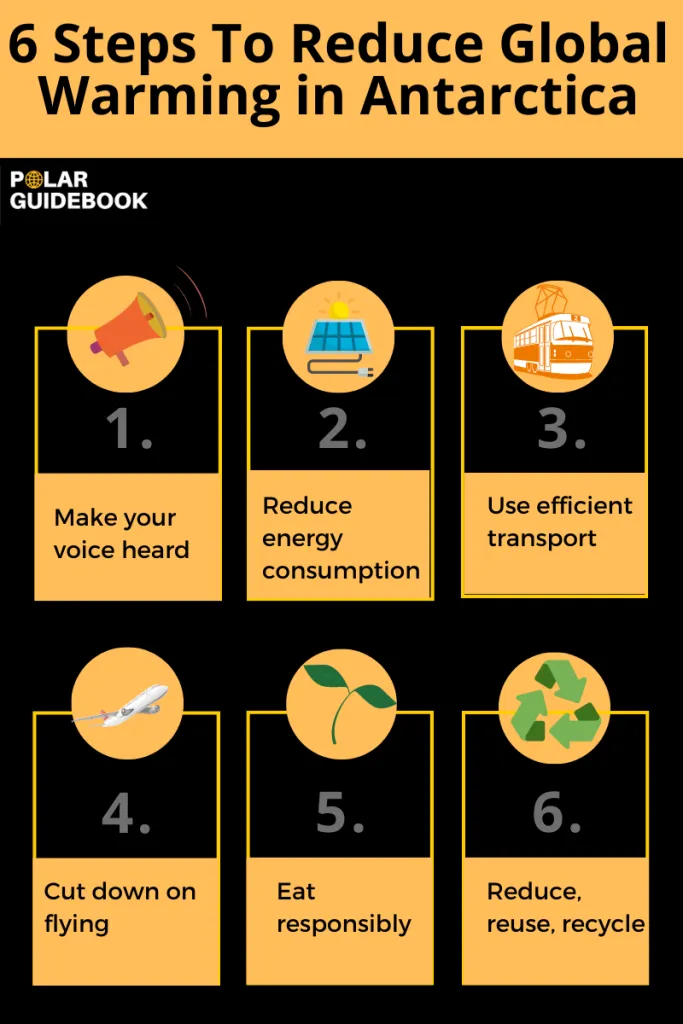The impacts of climate change and global warming on the world are now widely known although action tends to be slow. One of the regions most affected is Antarctica with impacts already visible. But, what can we do as individuals to help stop climate change in Antarctica?
We sat down with Professor Michael Hambrey, a prominent expert on glaciology, climate change, and Antarctica, who’s been researching and teaching for 50 years. Testament to his dedication and research, he has received two Polar Medals by The Queen, and had Hambrey Cliffs on James Ross Island in Antarctica named in his honour. Keep reading to get his insights.
- Global Warming in Antarctica: How is Climate Change Impacting Antarctica?
- How Melting Ice in Antarctica Affects the World
- How Can I Help Climate Change in Antarctica?
- How are Humans Helping Antarctica?
- Contribute to Charities Helping Antarctica
- What’s the Future for Climate Change in Antarctica?
- Related Questions
Global Warming in Antarctica: How is Climate Change Impacting Antarctica?
Collapse of ice shelves
According to Professor Hambrey, who has monitored Antarctic changes through satellite imagery and physical visits spanning two decades, the main changes that are evident in satellite images are the collapse of ice shelves in the Antarctic Peninsula over the last 4 decades.
“Since ice shelves act as a buttress to inland ice”, Prof. Hambrey tells Polar Guidebook, “their removal releases land ice so that it flows into the ocean faster – it is this process that adds to sea-level rise”.
He adds: “In West Antarctica two fast-flowing floating ice streams have been monitored by UK and US teams with international partners, owing to concern that they are thinning and fracturing. Ongoing studies of Thwaites Glacier, colloquially referred to as the Doomsday Glacier, is showing how its potential demise could release huge volumes of ice from the West Antarctic Ice Sheet into the ocean, and accelerating sea-level rise way beyond what climate models have predicted.
The causes of these changes are atmospheric heating, and also increasing ocean temperatures that results in melting of ice from underneath”.
Indeed, the Antarctic Peninsula has seen air temperature increases of almost 3°C over the last 50 years on average and reached a record high of 18.3°C in 20201 (source: World Meteorological Organization).
Harm to animals in Antarctica
The rising temperatures are having several effects on Antarctica on top of melting ice, including changes in vegetation and harm to the animals that live there.
The sea ice is vital for many animals in Antarctica. As it melts, penguins have to swim further to find food, and Antarctic krill (an important crustacean that’s vital in the region’s food chain) which rely on it for food and shelter have fewer places to thrive2 (source: Greenpeace).
Shrinking “cold bottom waters”
In addition, Povl Abrahamsen, a physical oceanographer at the British Antarctic Survey, co-authored a new report published in June 2023. The findings were worrying.
The report found that the volume of the “cold bottom waters” – important masses of extremely cold and salty water that help distribute nutrients across the ocean, absorb excess heat, and soak up man-made carbon pollution3 (source: CNN, https://edition.cnn.com/2023/06/12/world/antarctic-deep-ocean-water-shrinking-climate-scn-intl/index.html) – has shrunk over 20% over the past 30 years.
They also reported that ocean waters from the Weddell Sea deeper than 2,000 meters (6,600 feet) have warmed four times faster than the rest of the global ocean.
How Melting Ice in Antarctica Affects the World
One of the biggest impacts that climate change in Antarctica will have on the rest of the world is rising sea levels.
The volume of ice in Antarctica is not insignificant by any means. There are approximately 6 million cubic miles of ice which accounts for 90% of the world’s ice and 70% of the world’s freshwater4 (source: National Science Foundation).
As the ice melts in Antarctica, it will flow into the surrounding ocean causing sea levels to rise around the world. Most estimates suggest that if all of the ice in Antarctica melted, it will raise global sea levels around 60 meters5 (source; National Science Foundation).
“Probably the biggest threat to humanity”, Professor Hambrey tells Polar Guidebook, “is the fate of the West Antarctic Ice Sheet”.
He adds: “Thwaites Glacier is thought potentially within a human lifetime to ‘shatter like a car windscreen’. Along with Pine Island Glacier and others in the region, the demise of these outlet glaciers could trigger disintegration of the whole Ice Sheet, within which over 2 metres of sea-level rise are currently locked up”.
So how likely is it for this disaster to happen? Unfortunately, it’s a real possibility. Professor Hambrey concludes:
“This is not an impossible scenario, as it has happened in the geological past. The question is not if, but when and on what time-scale”.
Not only that, the melting ice causes a second problem. Currently, the ice puts a lot of pressure on the land underneath which has forced a proportion of it below sea level.
An estimated 23% of the ice in Antarctica is formed on land that is below sea level6 (source: British Antarctic Survey). But, as the ice melts and the weight on the landmass reduces, it may begin to rise and as a result, will push more water into the ocean7 (source: Science Advances, L. Pan. et al, Vol 7, Issue 18, 2021).
See our full article to find out what would happen if all of the ice in Antarctica melted
How Can I Help Climate Change in Antarctica?
According to Professor Hambrey, “society’s failure to tackle global heating, for which the science has been incontrovertible for three decades or more, has now left us in a state where global consequences are already coming home to roost”.
“From my perspective as a field glaciologist”, he adds, “the demise of glaciers has been staggering and deeply concerning. For Antarctica, as elsewhere, this means loss of ice and sea-level rise, potentially displacing hundreds of millions of people by 2050, particularly in the developing world.
We cannot now avoid some serious consequence of global heating, but failure to take the concerted action necessary will leave future generations with a devastated planet”.
“We cannot now avoid some serious consequence of global heating, but failure to take the concerted action necessary will leave future generations with a devastated planet”.
Professor Michael Hambrey, August 2023, in an interview with Polar Guidebook
So, what can we do to help climate change in Antarctica?
We’d do well to follow the advice given by Professor Hambrey. On a macro level, he calls for us to:
1. Phase out fossil fuel use rapidly
2. Prevent destruction of forests
3. Reduce the carbon footprint of agriculture
At an individual level, there are many things we can do. As an example, we can follow Imperial College, London’s guidance “9 things you can do to tackle climate change“.
Here are some practical steps you can take to help reduce climate change in Antarctica:

1. Make your voice heard
The best thing to do to help climate change is to make your voice heard.
Whilst we can all take individual actions to reduce our emissions as the following steps will cover, by using your voice to back good environmental initiatives and your vote to support parties with green policies, you can encourage much larger scale action on climate change.
As Professor Hambrey laments, we lack the statesmanship and moral leadership that is needed to combat climate change in Antarctica and elsewhere. Thus, raising one’s voice with our elected representatives is vital if we are concerned about climate change.
“With elections in the not too distant future (e.g. in the UK and USA), we need to tell our politicians that we will vote only for the party with strongest mitigation measures”.
This might be on issues related to carbon emissions or carbon capture such as planting more trees and maintaining existing green spaces.
2. Reduce energy consumption
Electricity and heat production is the biggest source of global carbon emissions so everyone has a role to play in minimizing these8 (source: Environmental Protection Agency).
Switching out your incandescent bulbs for more efficient LED bulbs and turning off devices when not in use are small changes that will add up over time. However, one of the biggest steps you can take to minimize your energy usage is to insulate your home.
This will not only have a benefit on your carbon footprint but in your pocket too. The Environmental Protection Agency estimates an insulated home can save 11% on total annual energy costs9 (source: ENERGY STAR®).
Key appliances to review in your home are your refrigerator and freezer which account for up to 13.7% of your home’s energy usage10 (source: US Energy Information Administration – EIA). Look for efficient models such as ENERGY STAR® certified devices in the United States or those with a high EPREL rating in the EU.
Aside from doing your part to reduce overall energy consumption, you can also consider using utility suppliers that focus on renewables or even install renewable energy sources in your home such as solar panels. Also look into air or ground-source heat pumps.
3. Use efficient transport
Although air travel often gets the most attention, passenger airplane travel accounts for 11.6% of transport emissions whereas passenger road vehicles account for 45.1%11 (source: International Energy Agency, 2019).
Switching to a more efficient vehicle such as a hybrid device or an electric vehicle can have a big impact. They are generally more expensive upfront, but you’ll also have a financial benefit over the lifetime of the vehicle due to lower running costs.
4. Cut down on flying
Just because air travel makes up a smaller proportion of total carbon emissions, this is due to the fact that only a small proportion of the population flies each year.
However, for those of us that do fly, the emissions will make up a large part of our carbon footprint. For example, a return trip from London to San Francisco emits around 5.5 tonnes of CO2 per person, that’s equivalent to half of the annual CO2 contribution from one person12 (source: BBC).
Reducing the number of flights you take and opting for road or even public transport is the biggest way to reduce your flying emissions. But, you can also fly more efficiently.
For example, taking non-stop journeys rather than multiple legs and flying economy where there are more people in the same space are two things you can do to reduce your carbon footprint from flying.
5. Eat responsibly
It might seem far-fetched that our diets can impact climate change in Antarctica, but it everyone does their part, it could have major positive impacts.
In the United States, meat accounts for 30% of average weekly household greenhouse gas emissions, more than any other food industry. Families that eat less meat (or no meat at all) have a much lower carbon footprint13 (source: A Comprehensive Life Cycle Assessment of Greenhouse Gas Emissions from U.S. Household Food Choices, R. Boehm. et al, 2018).
Another way your diet can help reduce your carbon footprint is by eating food grown locally so that it doesn’t rack up lots of air miles.
6. Reduce, reuse, recycle
Consumerism is a contributing factor to carbon emissions, not just in the production of goods but also in transporting them across the world. Studies suggest that the average consumer product results in carbon emissions 6.3 times its own weight14 (source: Carbon emissions embodied in product value chains and the role of Life Cycle Assessment in curbing them, C. J. Meinrenken. et al, Sci Rep, Vol 10, 2020).
A scheme known as the 3R’s encourages consumers to reduce, reuse, and recycle products.
The best way to minimize the impact of consumerism is to reduce the number of items you buy in the first place. This might be fewer presents or looking for items that have good repairability so that they don’t require replacing as frequently.
Next is the recommendation to reuse goods, this might involve buying or selling second-hand goods or even upcycling unwanted items. For those products that we cannot reduce or reuse, the final best thing to do is recycle them afterward.
7. Invest sustainably
The best way to show your commitment to reducing climate change is by putting your money where your mouth is. If you’re investing in funds or shares, ensure your investments are going towards responsible businesses.
There’s now a large market for ESG investments. These are investments that prioritize environmental, social, and governance (ESG) factors.
Studies have found that there is no financial trade-off to investing in sustainable funds compared to traditional funds15 (source: Sustainable Reality, Institue for Sustainable Investing Morgan Stanley). This is because they generally have a lower downside and are often more stable.
How are Humans Helping Antarctica?
As well as taking practical steps at home and in our own countries, organizations are working to mitigate the impacts of climate change in Antarctica itself.
Here are some examples of ways humans are helping Antarctica:
- The International Protocol on Environmental Protection in 1991 marked a big leap forward in the conservation of Antarctica. It protects Antarctica from mining, marine pollution, waste disposal, and more16 (source: British Antarctic Survey).
- Antarctica is home to some of the world’s first Marine Protected Areas (MPA) including the South Orkney Islands MPA and the Ross Sea MPA. These protect predators, prey, and biodiversity in the relevant areas by limiting activities such as commercial fishing17 (source: Commission for the Conservation of Antarctic Marine Living Resources).
Contribute to Charities Helping Antarctica
All of the above recommendations are practical ways we can all help climate change. However, if you’d like to make a more direct contribution to mitigating the effects of climate change in Antarctica, there are several charities you can donate to.
Here are some charities you can contribute to:
- WWF – Through their ‘adopt a penguin’ they help safeguard wildlife in Antarctica, reducing illegal fishing, raise awareness of climate change.
- Antarctic and Southern Ocean Coalition (ASOC) – This is a coalition of NGOs that have been formed to help protect the integrity of Antarctica from human activity. They are specifically mentioned as an observer in The Antarctic Treaty.
- Greenpeace – Greenpeace have played a key role in campaigning for the protection of Antarctica from exploitation and continues to fight for the region. Whilst you can’t donate directly to their work in Antarctica, you can support the charity as a whole and help their vision for a greener, healthier, and more peaceful planet.
What’s the Future for Climate Change in Antarctica?
The future for Antarctica is not looking good. Scientists suggest that there is no feasible way of slowing down the melting of the six glaciers in west Antarctica which hold around 10% of the ice in Antarctica. Some are likely to disappear within 200-500 years18 (source: Geophysical Research Letters, E. Rignot. et al, Vol 41, Issue 10, 2014).
That might seem like a long time, but impacts are expected across the globe within our lifetime with sea levels predicted to rise by almost 1m by 210019 (source: Intergovernmental Panel on Climate Change, 2013).
Experts predict that the melting of these glaciers is now beyond the point of no return20 (source: Time).
Whilst there is still time to reverse the trend of global warming, there will be impacts on the continent of Antarctica regardless of any changes we make.
Related Questions
Is There a Connection Between Global Warming and the Ozone Hole?
The ozone hole is an area in the stratosphere above Antarctica where ozone-depleting chemicals have destroyed ozone molecules. This allows more UV rays from the sun to enter the atmosphere.
Whilst there is a connection between the ozone hole and global warming, neither one is the cause of the other21 (source: NASA).
The ozone hole varies throughout the year, but since the Montreal Protocol banned many ozone-depleting chemicals, the general trend now suggests the ozone hole is getting smaller, allowing for annual variances22 (source: World Meteorological Organization).



![You are currently viewing How Does Climate Change Impact Antarctica? How Can We Help in 2023? [According to an Expert]](https://polarguidebook.com/wp-content/uploads/2021/07/How-Climate-Change-Impacts-Antarctica.jpg)
![Read more about the article How to Get a Job in Antarctica in 2024 and 2025 [According to People Working There]](https://polarguidebook.com/wp-content/uploads/2023/08/Untitled-design-23-300x176.png)
![Read more about the article Arctic vs Antarctica [12 Key Similarities and Differences]](https://polarguidebook.com/wp-content/uploads/2021/07/Arctic-vs-Antarctica-300x176.jpg)
